By Christopher Pinner
On November 15th, 2011, the Halo franchise turns ten years old. To commemorate this, Microsoft is releasing an updated version of the first game. As a Halo fan, this anniversary offers an opportune moment to look back on the entire series, a series which has simultaneously changed console gaming, while also capturing in each iteration a bit of the gaming zeitgeist (both good and bad) of its time.
Pre-Halo
Halo was created by Bungie Studios, a developer that prior to being bought by Microsoft had worked exclusively on Macs (with a few PC ports). Bungie’s games were known for being top-quality entertainment, well-designed games resting on top of unusually well-developed in-game fictions, in a market (the Mac) that didn’t have a lot of developers. The Marathon series in particular is still today heralded for the unique way it told its story, and the way in which it toyed with the player.
In 1998, at the annual festival of Apple love that was MacWorld, no less than Steve Jobs announced that Bungie was making a game called Halo. Little remains of the original builds of Halo, but it was known that it was a real-time strategy game, set in a science fiction universe. The next time much information is given out on the game is E3 2000, where the game has shifted to be a third person action game, in which a group of humans crashed on a giant ringworld, which also had some aliens on it who fought the humans. Notably (given the future relationship between the series and the system), this convention is also where the first early development version of the Xbox was shown, though mostly behind closed doors.
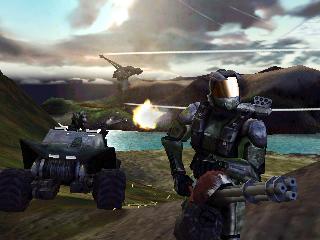
An early screenshot of the third-person Halo
Shortly after this convention, Microsoft revealed that they were purchasing Bungie, and that Bungie’s newest game would be built for the Xbox. As you can imagine, certain Mac-loving sections of the internet were in a bit of an uproar about it.
The Design of Halo
With the purchase by Microsoft, Bungie set about rewriting the engine to run on the new system. In the course of doing this, the game switched to being a first person game, and Microsoft decided that it was to be the flagship title for the Xbox. Halo: Combat Evolved (as the full title became) was released with the launch of the Xbox itself, and quickly became the game that everyone who owned the system probably owned.
Console first-person shooter (FPS) games had been tried numerous times, but none (save the efforts of Rare for the Nintendo 64) ever gained traction the way Halo did. Halo carried the original Xbox on its shoulders. Looking back now, it’s clear why. Halo was designed not just to be a first person shooter, but as an FPS specifically tailored to the strengths and weaknesses of a console controller. FPS games on PCs largely relied on the WASD keyboard and mouse controls that remain widely used today. Console games couldn’t match the precision aiming capable with a mouse, but were simultaneously capable of providing better analogue movement. To work around the lack of accuracy, Bungie implemented weapons that either had good spread in their bullet spray, or some degree of homing. Similarly, movement became more important with the implementation of widely available melee combat and vehicles.
The consciousness of the limitations of console FPS controls would’ve probably been enough to make Halo a well-received game among console gamers eager to play a decent FPS, but Bungie did a lot more with Halo than just that. The origins of Halo as a real-time strategy game are important to remember, because the rock-paper-scissors ideology at the heart of RTS games (in which each unit/tactic has both something it is strong against and something it is weak against) informs so much of the actual design of Halo. The basic design of Halo’s combat follows this RPS model in what has come to be known maybe-not-entirely-jokingly as “the holy trinity”: guns, grenades, and melee. Each of these elements was treated as equally important in Halo’s fighting, and each has strengths and weaknesses.
Every gun in Halo is good at one basic thing, even if that thing is “being the general gun you keep around because it isn’t great at anything, but can be handy as a back-up plan” (the assault rifle). Guns in Halo were designed around what kind of damage they do. Gone were simple HP meters; in were the regenerating shields overlaying health points that were sometimes also buried under armor. To kill an enemy, you have to get rid of its shields or figure out some way to ignore them, then get rid of its health. If you don’t do that fast enough, the shield comes back. Each gun is individually focused on different ways of damaging the enemy. The plasma pistol, for example, is ridiculously proficient at destroying shields, but if you shoot unshielded enemies with it, they won’t be damaged much at all.
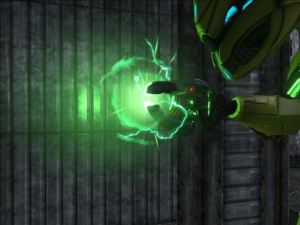
The plasma pistol.
This might be interesting enough on its own, but Halo only lets you carry two guns at once, forcing you to carefully pick and choose which weapons you want to take with you. Though it’s hard to remember now, since so many games have aped this particular idea, this was relatively innovative at the time. Part of this design decision is clearly just working with the button limitations of a console controller. Even more than that, however, it is forcing the player to constantly make decisions that will affect the rest of the game. It’s a workaround for the limitation of consoles, in that normal FPS arsenals would seem unwieldy, but Halo, Bungie turns this workaround into a virtue.
Just like the guns, the grenades were designed around the limitations of the console. Grenades were given their own button, the left trigger (whereas guns used the right), showing their intent as separate but equal to guns in usage. This dedication of a button is another oft copied innovation of the Halo games, but it wasn’t the only way in which grenades were given precedence in the game. Halo originally featured two types of grenades:human (normal grenades) and alien/plasma (sticky grenades). Though these types were later expanded, the original two are enough to get an impression of what is going on design-wise. On their own, grenades combined aiming with movement by having limited ranges and adjustable trajectories, working again to the strengths/weaknesses of console controls. However, with the different types, Bungie allowed for different strategic options. Human grenades damaged unshielded enemies more, and had a wider area of effect. Plasma grenades stuck to enemies and had a limited area of effect, but would destroy shields.
Melee is the aspect of Halo’s combat that is most focused on console controls, relying on movement almost entirely. In addition to being given prominence by getting a dedicated button, melee is advantageous due to its ability to kill enemies with one hit from behind, with exceptions for larger enemies of course. In later Halo games, there are even weapons dedicated solely to melee such as plasma swords, and because of this, melee combat has become a hallmark of the series.
The Design of the Campaign
In a campaign, let alone in multiplayer, all of this RPS-style combat design would be meaningless without anything decent to fight, and Bungie has worked to build on that in a way that clearly recalls Halo’s RTS origins. Enemies in Halo have different abilities, weapons, and strengths that make them optimal in certain situations, and strong against some weapons but not others. The lowest enemy, the Grunt, has no shields, but is armed with grenades and plasma pistols, and usually work in numbers. The Grunts are also usually accompanied by an Elite, a shielded enemy that usually carries a stronger gun. Other enemies have shields that protect them from a few directions (the Jackals), or an incredibly high amount of armor (the Hunters). Each enemy requires different strategies to effectively eliminate, and each has an AI that seems to know it.
The AI was a big innovation in Halo. Sure, it will never be the same as playing against a human, but what the AI in Halo does is react to the player, creating a somewhat different experience based on what the player does in each encounter. Enemies may flank you, or they may panic at seeing their stronger counterparts eliminated. Knowing the AI will somewhat dynamically react to the actions of the player forces players to strategize ahead of time, and to improvise if those plans go wrong.
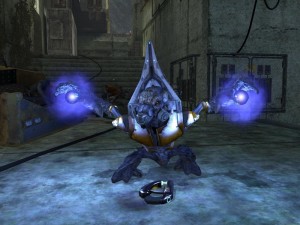
Grunts can become suicidal if they are panicking.
The final piece of the design puzzle in Halo’s campaigns is co-operative play. Halo is certainly not the first game to offer co-op play, but co-op in Halo changes a lot about the game. It offers extra ways to plan for coming fights, and extra forces for the AI to react to. Vehicular combat, something of a minor feature for most of the game if playing alone, becomes much more involved when someone else is in the vehicle with you. Co-op in Halo often ends up (at least for me) becoming an escalating series of strategies and dares, finding out the most ridiculous way to accomplish something, and seeing if you can do it. It lends a itself to replaying in a manner that is lacking in so many other games.
What truly makes the Halo campaign work, at its best, is the way Bungie has trusted the system of the game to play itself out. This isn’t to say there is no scripting at play in a campaign fight, but each time a player encounters a fight, something new may happen. Enemies may react differently, a grenade dropped by a dying enemy may set off a chain reaction of subsequent explosions, and so on. Halo’s campaigns are best understood then as a system of set units, each with rules, allowed to play out according to those rules and be experimented on by the player. In some of the more memorable battles, this system of setting up rules and letting them play out can truly shine.
Multiplayer
As much as I have focused on the campaign, the multiplayer has always been as essential to Halo’s success as the campaign. Halo’s multiplayer mode is built on the same fundamental mechanics as the story mode, but has always tried to offer something a bit different to players.
Previous FPS console games were generally limited to 4 players, being the most that could be reasonably accounted for on a screen. Bungie initially planned for Halo to be playable on Microsoft’s Xbox Live service. When it became apparent that the service was not going to be ready for the launch of the system, Bungie still made use of the built in Ethernet port of the original Xbox to enable console linking. This created a small community of console local area network (LAN) players, a previously unheard of idea, as LANs had long been the realm of PCs. When online play finally was introduced in Halo 2, there was already a large multiplayer community ready to jump into it.
The other clever thing Bungie did was allow for the easy tweaking of multiplayer options, echoing the N64 games of Rare, which allowed/encouraged players to create with their own variations on the game. In subsequent versions of Halo, more and more customization features have been introduced, including Forge mode, a full level editor that has allowed the creation of all kinds of games and modes in a way that few other console games have matched. The whole game of Griffball, for example, was originally just a mod to a Halo 3 map that has taken off on its own.
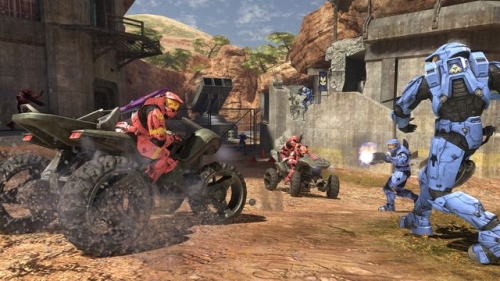
Halo’s multiplayer allowed for a variety of different types of fights.
In addition to allowing an unheard level of customizability for a console FPS game, Halo also provides players with a decent variety of levels for different scales of fights. Smaller, tighter maps work great for 4 players, while larger maps with vehicles can accommodate the full sixteen players. Modes of play such as King of the Hill work great with a few players, while giant Capture the Flag matches take place at LAN parties regularly. Halo became an FPS experience similar to what PC players had been enjoying for years, but on a console. And it probably helped keep the fledgling Xbox alive.
Halo: Combat Evolved
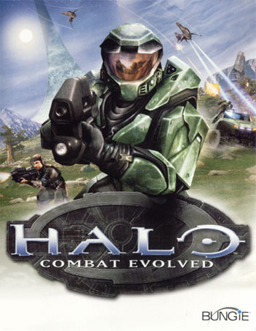
The Xbox had a few very interesting features that Halo was designed around, that also seem almost prescient in their inclusion in a game system. The Xbox was the only system of its generation to feature an built-in Ethernet port, enabling the linking of systems and eventually the promise of online play in a world where broadband access was becoming more widely available. While the Dreamcast, Playstation 2, and Gamecube could all be upgraded to support broadband play, the Xbox had it from the start, even if the network itself wasn’t operational at launch. The Xbox also uniquely had a hard drive, which Bungie used to help make their large scale levels a reality.
Microsoft bought Bungie with the explicit goal of having a solid first-party developer for their new system. Bungie, in turn, delivered a game that largely powered the sales of the system, and greatly changed how console FPSes were designed to this day. Had Halo:CE not happened, Microsoft might have risked failing in an already tough market, and Sony and Nintendo would’ve been left with total control of the market (with the sad fading of Sega and the Dreamcast). FPS games might have remained largely in the realm of the PC, which would certainly have an impact on several other large companies and franchises (not the least of which being Call of Duty). Halo’s impact was huge.
Halo 2
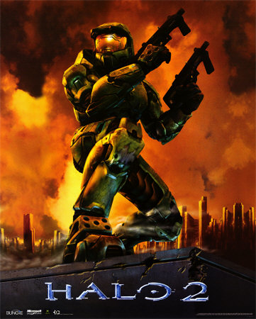
Halo 2 wouldn’t have the same impact as the first game, and it couldn’t. Many of the design innovations of the first game were becoming standard in FPSes, and the Xbox had established itself in the console market, even if it couldn’t match the sales of the dominant PS2. Halo 2’s engine, while updated from the first game, started to show the limits of what the console could do. Though the graphics looked good for the time, texture pop-in became a major problem. A fight against a larger Covenant enemy, the Scarab, turned out to largely be a boringly scripted battle, whereas Halo at its best has avoided such a high amount of scripting in its fights. What Halo 2 did do, however, was show that there was a market for online console gaming that had yet to be fully tapped into.
Consoles had gone online before, with varying degrees of success. Sega had experimented with online play with the Dreamcast, but the combination of limited sales and the switch from modems (which the Dreamcast came with) to broadband caused some issues. Sony was working on implementing an online system, but it required separate purchases and had yet to materialize much. Microsoft had launched their Live service, but the few games playable had really failed to take off with most players.
Halo 2, though, had the advantage of the built-in player base from the first game’s multiplayer, and they definitely helped the game become a dominant online force. If you played any game over Xbox Live, odds were good that it was Halo 2. Expanding into online let Bungie make the multiplayer segment of the game even larger, even if the campaign itself suffered a bit. The cliffhanger ending and general lack of polish in the campaign irked players (self included), and sadly the online play didn’t include the co-op campaign.
With those limitations in mind, though, Halo 2 did prove that online multiplayer was going to be a supremely important force in console gaming. Halo 2 also highlighted some of the big problems of online gaming, though, with cheats and exploits becoming an issue. In what is now regarded as normal for online games, patches were rolled out to address these, and the modern console patching era began. What patches couldn’t fix, however, was who you were playing against, and it quickly became apparent in Halo 2 that giving gamers microphones and some degree of anonymity would lead to a wide variety of horribly racist/sexist/homophobic drivel pouring forth constantly. As anyone who has played much on Xbox Live can tell you, this sadly continues to this day, though at least muting people is easier now. Interestingly, Halo 2 was also one of the first console games to sell downloadable content, in the form of map packs. What has become an industry standard in the current generation really got off the ground here.
Halo 3
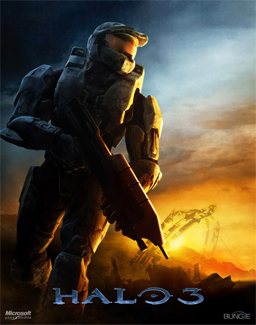
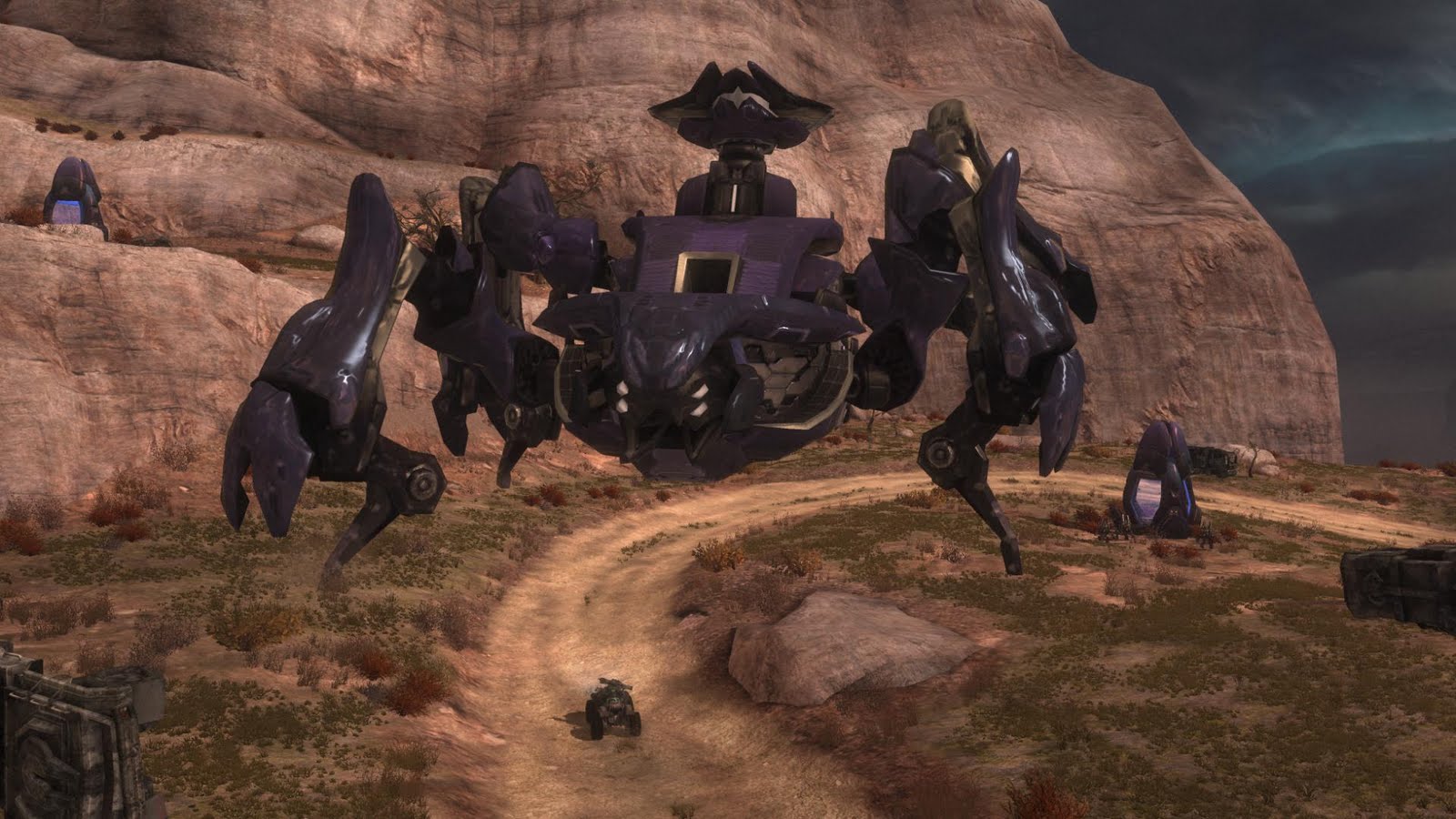
A Scarab, with a player on an ATV in the foreground for size comparison (from Halo: Reach)
The 360 was designed from the beginning to take advantage of Microsoft’s Xbox Live service, and Halo 3 integrated it as much as possible. In addition to having online co-op, Halo 3 featured an expanded multiplayer mode, as well as allowing for file sharing over the Live network. Players could watch replays of previous matches of campaign missions, capturing screenshots and short films to share on the network. Though PC gamers had been doing this for years, this marked the first time such tools were available to console gamers.
Halo 3 also introduced what is probably the most lasting change to the online Halo experience, Forge mode. Forge mode allowed players to modify and change existing multiplayer maps, adding in obstacles, weapons, and even changing the rules of the game. This led to the spawning of numerous player-made modes for the game, including Rocket Race (teams of two players sharing one scooter, which one drives while the other shoots unlimited rockets at other players, all racing to get to checkpoints) and Grifball (a soccer-like Halo game). Again, modding of games was common on PC FPS games for years prior to this, but Forge mode made it easy to make and share on the console, and really separated Halo 3 from other console games.
Halo 3:ODST
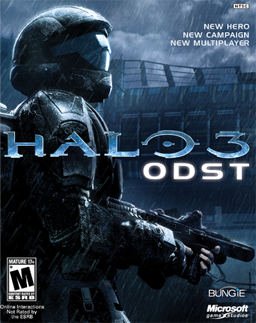
ODST is a very interesting shift for Halo campaigns. The player plays mainly as a character trying to track down his squad after a disastrous landing in a wartorn city, and as the player tracks down squad members, he or she will play as each member of the squad in flashbacks. In effect, this meant that the main part of the story was spent in the open city, coming across groups of Covenant soldiers while trying to track down the next piece of evidence, which would then start a standard Halo level.
Making this more difficult was the fragility of the human characters. Whereas in previous Halo games, the player could charge into battle and stand a decent chance, The ODST soldiers were not as resilient, so fighting often meant combining some degree of stealth with careful use of cover and weapons selection. For the first time in the series, the basic tactics of combat had to change.
While ODST did not feature any net versus combat, it did introduce a new multiplayer co-operative mode, Firefight. Firefight places a group of players on a map as they attempt to fight off wave after wave of Covenant troops, with escalating numbers, strengths, and advantages. This original Firefight mode was fun, but flawed, in that it seemed it could go on infinitely, so once players got good at a particular level, their scores were only limited by their attention spans. Still, it was an interesting mode, and one Bungie would develop further in the next Halo game.
Halo: Reach
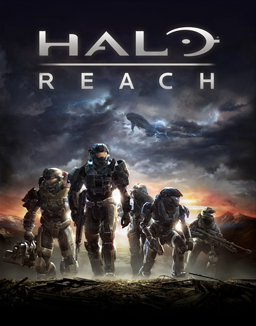
It’s tempting to see this tone coming from Bungie themselves, as this was their last work on the series. Their contract with Microsoft was ending, and since Microsoft owns the rights to Halo, they would no longer be working on it. 343 Industries, made up of both new developers and some former Bungie staffers, was taking over the series, so it seems like Bungie might have been a bit sad to be leaving Halo behind. Or it would, if so much of the game hadn’t been filled with the kind of care and attention that Bungie is known for. Multiplayer received a lot of attention, including a new mode centered on recreating fights between the Covenant and the humans. Firefight was tweaked and developed into a tightly focused, score-running mode. Forge was greatly expanded, including the creation of a massive multiplayer level known as Forge World, specifically built to let players create and build almost anything they could think of.
When it came time for Bungie to finally leave the game to 343, they went out with a big online celebration, challenging players to games, with the prize for beating the devs being a steak mailed to the players. Bungie clearly poured a lot of love and effort into the final game, and it showed.
The Future of Halo
Halo is now in the hands of 343, and who knows what that will mean. The remake of Halo: Combat Evolved is the first effort from 343, but not the first non-Bungie Halo game. That would be Halo Wars, a real-time strategy game developed by Ensemble Studios, which I have not played extensively, so I didn’t feel comfortable commenting much upon it. 343 have a lot to live up to with this series, and they have already begun work on Halo 4.
Halo as a series brought first-person shooters to consoles by tweaking them for console play in unique ways, many of which have become industry-standards in new console FPSes. Though I haven’t talked much about it here (mainly because it would take much more time to fully discuss), Halo also featured an incredibly well-developed science fiction universe, starring some truly memorable characters. In doing all of this, Halo has had a gigantic impact on gaming as a whole, and even if 343 manages to mangle the series, Bungie can be proud of their time with and work on the Halo series.